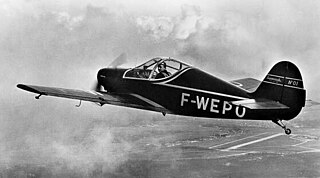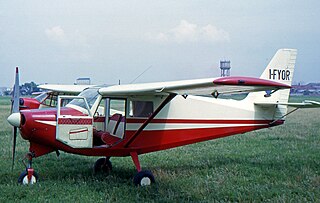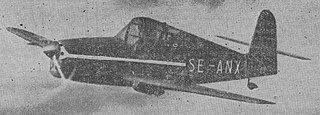
The RA-14 Loisirs was a French two-seat high-wing light touring aircraft designed by Roger Adam shortly after World War II.

The SAI KZ III Laerke was a Danish light utility aircraft used by the Danish Air Ambulance Service and Danish Air Force.

The MKEK-4 Uğur was a basic trainer aircraft which was used by the Turkish Air Force between 1955-1963. Originally developed as the THK-15, in total 57 Uğurs were produced in Turkey, all of which were used in the Turkish AF Flight School except three which were donated to the Royal Jordanian Air Force.
The Auster Avis was a four-seat light aircraft developed from the Auster Autocrat. It featured a redesigned fuselage incorporating four doors and a circular cross-section towards the tail, new undercarriage, and new wing flaps. It was planned in two versions, the Mk 1 for civil use, and the Mk 2 for military and air ambulance duties. However, only two prototypes were built, and Auster abandoned the project in favour of the Auster J-5 Autocar.

The Luton Buzzard was a 1930s British single-seat, open cockpit ultralight aircraft built by Luton Aircraft Limited.

The CAB GY-30 Supercab was a two-seat light aircraft built in France in 1954, as a further development of the CAB Minicab. The design was performed by Yves Gardan, a onetime employee of French aeronautical company SIPA. Changes incorporated in the Supercab included a more powerful engine, greater wingspan, manually retractable undercarriage, and slotted flaps that replaced the split flaps of the Minicab.
The Boisavia B.260 Anjou was a four-seat twin-engine light aircraft developed in France in the 1950s. It was a low-wing cantilever monoplane of conventional configuration with retractable tricycle undercarriage. Intended by Boisavia as a touring aircraft, it did not find a market and only the single prototype was constructed. At this point, the firm sold the design to SIPA, which modified the design and re-engined it with Lycoming O-360 engines, but found that they could not sell it either. At a time when the twin-engine light plane market was already dominated by all-metal American aircraft, the Anjou's fabric-over-tube construction was something of an anachronism, and all development was soon ceased. Plans to develop a stretched version with three extra seats and Potez 4D engines were also abandoned.
The Partenavia P.55 Tornado was a 1950s Italian high-performance competition and touring monoplane built by Partenavia. The Tornado was a small mid-wing cantilever monoplane with a retractable tricycle landing gear. The aircraft was powered by a nose-mounted Lycoming O-320 piston engine.

The Partenavia P.57 Fachiro is an Italian, four-seat, high-wing, touring monoplane, fitted with a fixed tricycle undercarriage.

The Varga 2150 Kachina is an American all-metal, low-wing, fixed-gear, two-seat light aircraft fitted with a tricycle undercarriage.

The SIPA S.90 was a French-built two-seat light touring and training aircraft of the 1940s and 1950s.

The Potez 75 was a low-cost, simple, ground-support, observation and launch aircraft for anti-tank missiles, designed and built in the early 1950s, for use in colonial conflicts. One hundred and fifteen were ordered in 1956, but cancelled in 1957.

The Ambrosini Rondone is an Italian-designed two/three-seat light touring monoplane of the early 1950s.

The Scheibe SF-23 Sperling (en:Sparrow) is a 1950s German two-seat cabin monoplane.

The Skandinaviska Aero BHT-1 Beauty is a 1940s Swedish single-seat light monoplane designed by E. Bratt, K.E. Hilfing and B.Törnblom and built by Skandinaviska Aero of Stockholm.

The Starck AS-80 Holiday is a conventional two-seat, single-engine high-wing monoplane designed and built in France around 1950. It was sold in kit form but only a few were completed.

The Starck AS-57 is a single engine low wing monoplane seating two in side-by-side configuration. It was designed and built in France just after World War II; only ten were produced, one of which was still active in 2012.
The SIPA S.70 was a late 1940s French eight-passenger light transport aircraft prototype built by Société Industrielle Pour l’Aéronautique (SIPA).
The OFW OK-15 was a 1950s Austrian two-seat light aircraft. Designed by Otto Kauba and built by the Österreichische Flugzeugwerke GmbH (OFW) at Wiener Neustadt, it was the first aircraft to be designed and built in Austria for 20 years.

The Pottier P.130 Coccinelle is a French light aircraft originating from one designed, but not built, in the 1960s. Redeveloped thirty years later, it is a homebuilt, single engine two seater. More than twenty have been constructed.
















